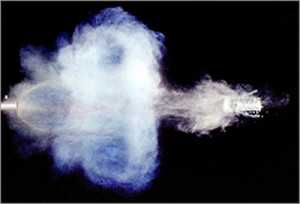
Cloud of particulates formed at firearm discharge to determine the distance a weapon was fired. Source: US Fish and Wildlife Service.
Last month, Bill Capo of New Orleans’ WWLTV posted a report on changes in that city’s police crime lab since Katrina. When Ronal Serpas assumed the position of crime lab superintendent, he found that the hurricane had destroyed the original lab, leaving a facility that barely functioned.
“This crime lab was basically dead on arrival,” Serpas told Bill Capo. “It was having very little success in doing firearms examinations. There was no real work going on with DNA.”
Serpas initiated a program to rebuild the lab with an emphasis on firearm identification to tackle the increasing number of violent crimes.
“It’s unbelievable the volume of work the firearms unit has done,” said Captain Michael Pfeiffer, the crime lab’s commander. “No place else in the country touches the volume of work this unit does. I can guarantee you, pound for pound, we are faster and better than anybody you want to look at.”
One outcome of the analysis is the finding that in many cases the same guns are used to commit multiple crimes. Investigators use the information to identify links between two or more crimes.
“There’s a small group of people out there committing a majority of the gun violence that occurs in the city of New Orleans,” Pfeiffer told Bill Capo, “and the more we can show the linkages between those people, and between the cases, the more likely we are to take, not just individuals, but groups off the street.”
If you plan to include forensic firearms analysis in your story, then watch the video of this report for insights into a real lab.
